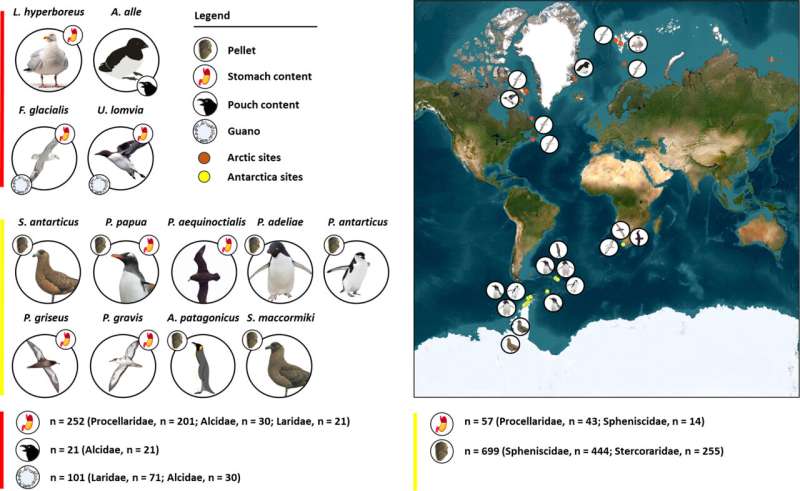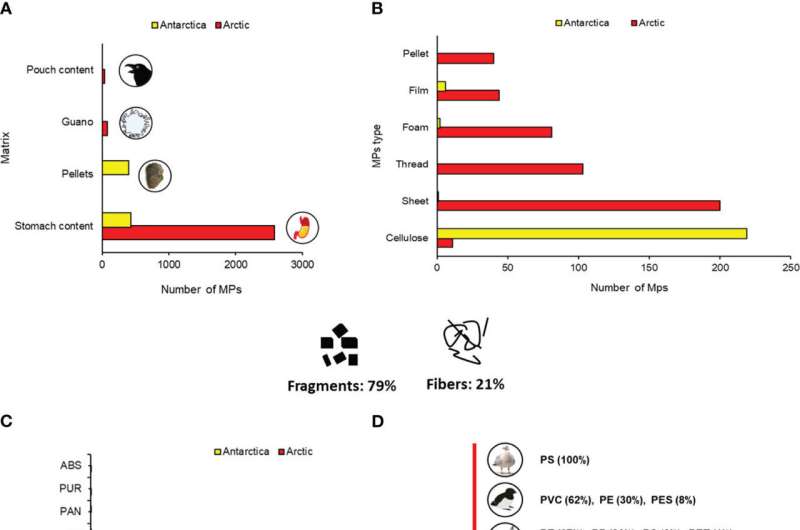March 14, 2024 feature
This article has been reviewed according to Science X's editorial process and policies. Editors have highlighted the following attributes while ensuring the content's credibility:
fact-checked
peer-reviewed publication
trusted source
proofread
Polar plastic: 97% of sampled Antarctic seabirds found to have ingested microplastics

Anthropogenic plastic pollution is often experienced through evocative images of marine animals caught in floating debris, yet its reach is far more expansive. The polar regions of the Arctic and Antarctica are increasingly experiencing the impacts of plastic reaching floating ice and land, not solely as larger macroplastics (>5 cm), but as microplastics (0.1 µm—5 mm) and nanoplastics (<0.1 µm) that may be carried vast distances from their source or be ingested in more populated areas during seasonal migration.
A new review, published in Frontiers in Marine Science, has investigated the scale of this issue, particularly with respect to seabirds who call these glaciated regions home.
Ph.D. researcher Davide Taurozzi and Professor Massimiliano Scalici, of Roma Tre University, Italy, embarked on a project to summarize 40 years of research into seabird ingestion of microplastics, from 1983 to the present day.
Across >1,100 samples, the researchers explored stomach contents, crop pouch near the throat for temporary food storage during foraging trips, guano (excrement mixture of food and metabolic waste) and regurgitated pellets of undigested food and other particles. Pellets formed the main component of the samples, followed by stomach contents and guano, while pouch contents were minimally present.
They found that 13 species of seabird inhabiting polar landscapes were reported to have ingested microplastics, including little auks, northern fulmars, glaucous gulls, thick-billed murres, white-chinned petrels, great shearwaters, sooty shearwaters, king penguins, Adélie penguins, chinstrap penguins, gentoo penguins, brown skuas and south polar skuas.

A total of 3,526 particles were extracted from these seabird samples, equating to at least 1 microplastic particle in 90% of Arctic samples and 97% for Antarctica. A median of 31.5 and 35, and average of 7.2 and 1.1, microplastic particles were found in each sample in the Arctic and Antarctica respectively. A maximum of 36 microplastic particles were found in a single bird.
Regarding plastic composition, 14 polymer types were identified, the dominant form being polyethylene, followed by polypropylene and polystyrene. These were predominantly present as fragments, derived from the breakdown of larger plastic objects. Such plastic polymer types can be sourced from items like plastic bags, food and drink containers and protective foam packaging.
The impact ingestion of plastic particles can have on seabirds includes blockage of their gastrointestinal tract, toxicity and oxidative stress, as well as triggering immune reactions. Additionally, it is not only direct ingestion of particles that is of concern, as microplastics have been found in krill, a food source for some penguins, highlighting the larger-scale issue in the ecosystem and trophic webs.
Currently, there are 64 and 43 species of seabirds inhabiting the Arctic and Antarctica respectively, but their numbers have been declining over recent years, giving rise to the need for stricter conservation measures.
Considering the Arctic covers ~6% of Earth's surface and is comparatively pristine, the implications of human encroachment on the natural world here can be devastating. Beyond plastic pollution, there are additional pressures of expedition tourism, commercial fishing and maritime routes in the North Sea being used more frequently, and the ever-concerning pressure of global warming on melting ice, resulting in temperature, salinity and sea level fluctuations.
Anthropogenic impacts on biodiversity in the Arctic and Antarctica are proof that no parts of the planet are immune to the effects of our activities, thus concerted strategies to mitigate environmental stressors must be an ongoing conversation.
More information: Davide Taurozzi et al, Seabirds from the poles: microplastics pollution sentinels, Frontiers in Marine Science (2024). DOI: 10.3389/fmars.2024.1343617
Journal information: Frontiers in Marine Science
© 2024 Science X Network





















